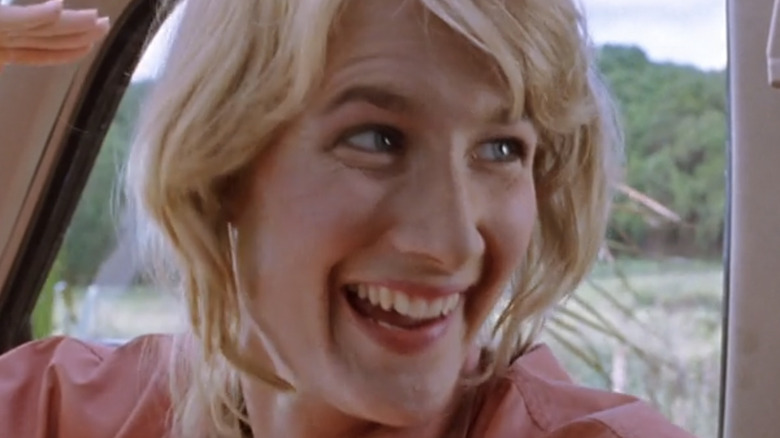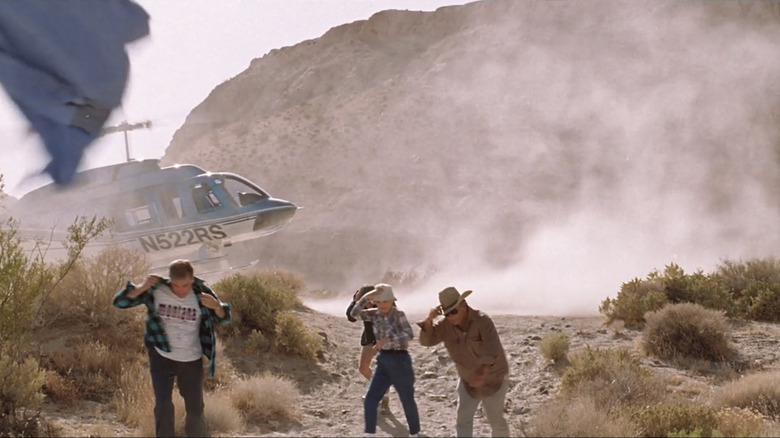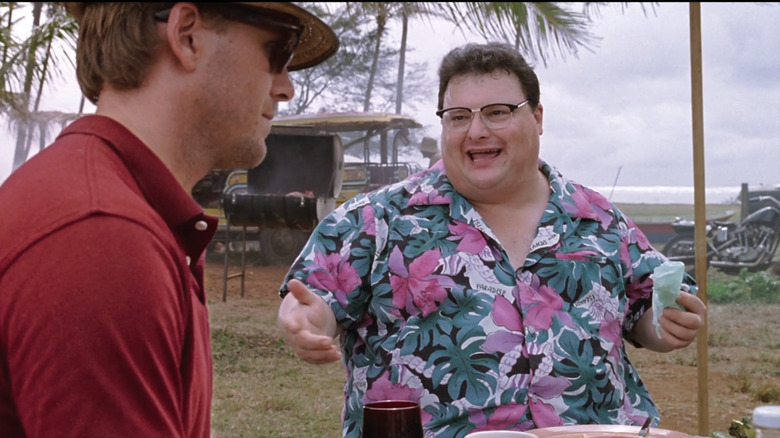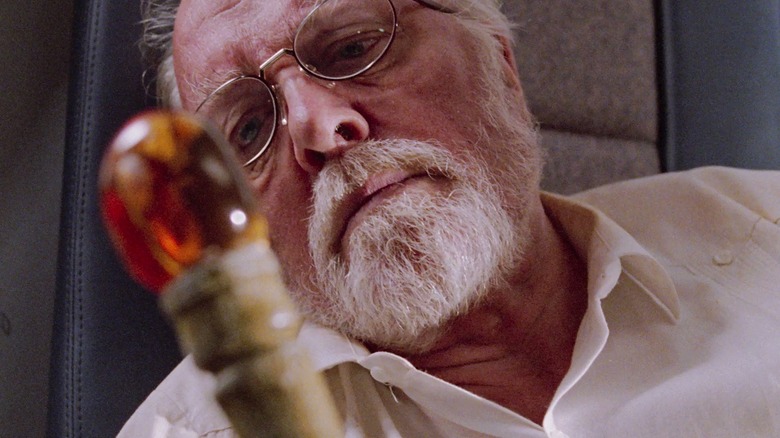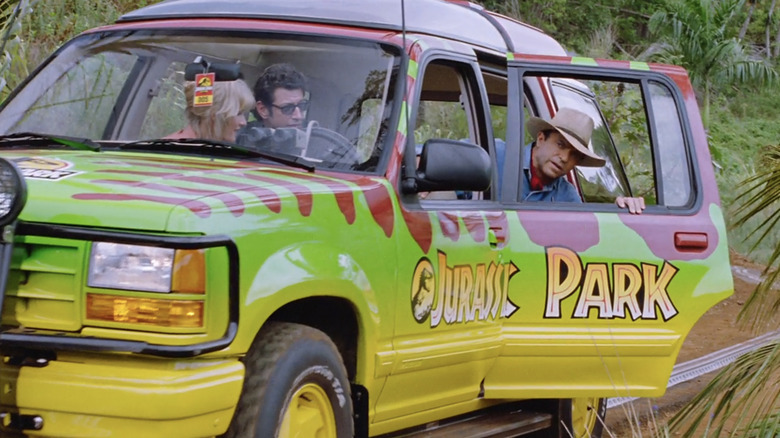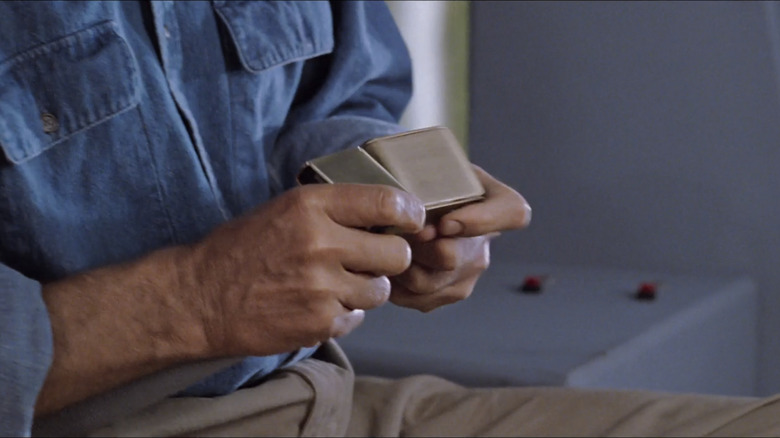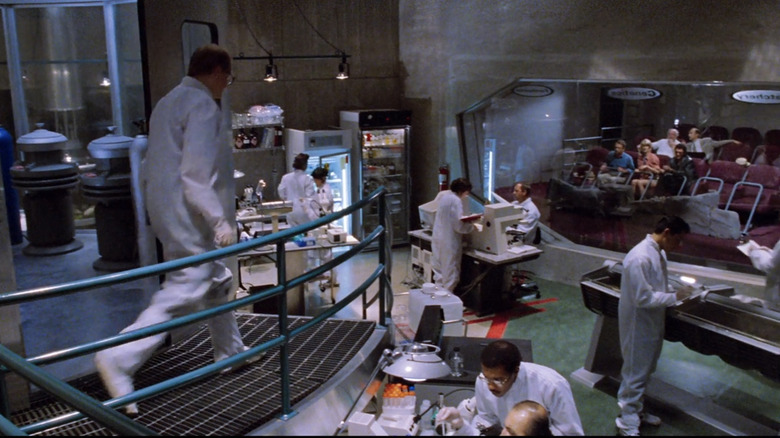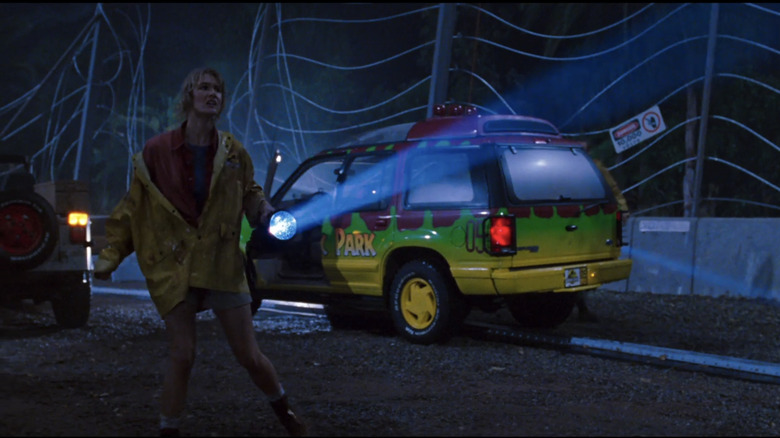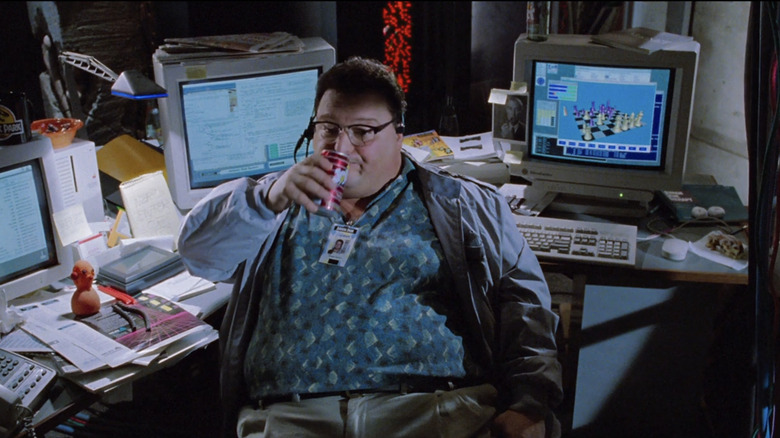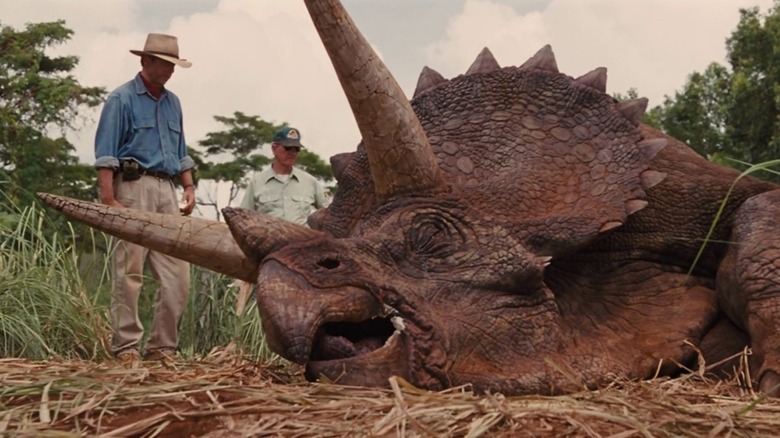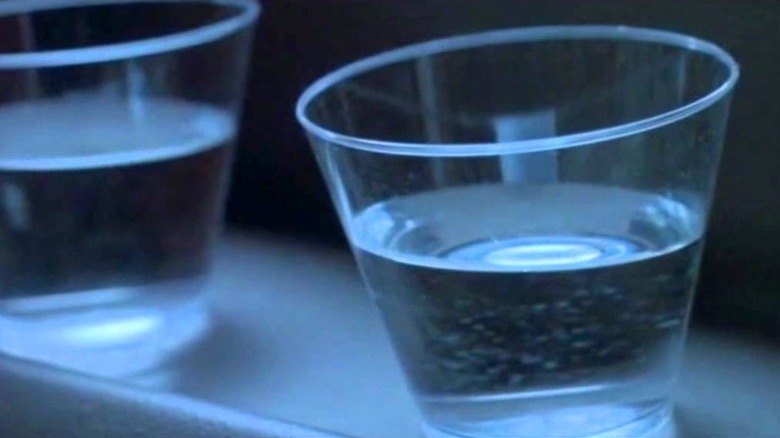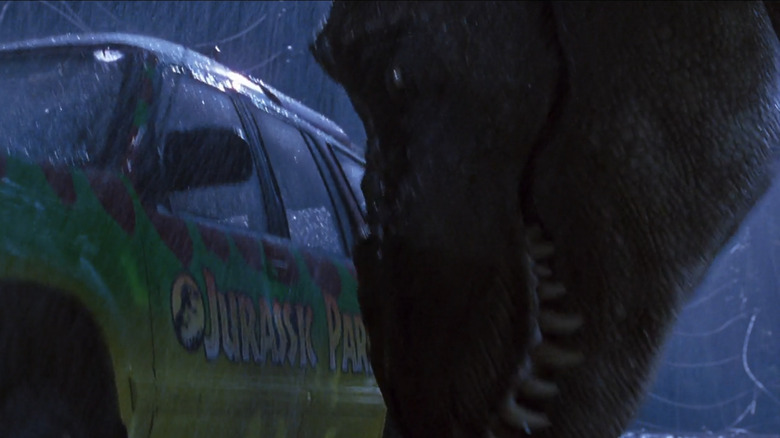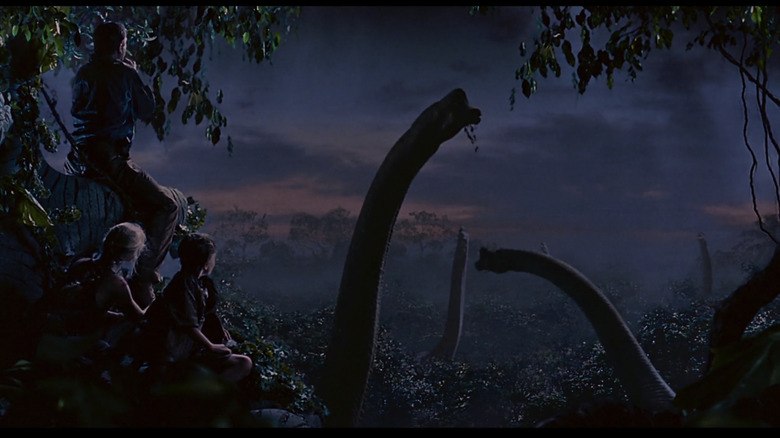Things Only Adults Notice In Jurassic Park
Thirty years and five sequels later, "Jurassic Park" still stands as a one-of-a-kind action spectacle. Uniting prehistoric monsters with the latest CGI technology, this movie changed the face of special effects forever. And even if some of those effects look less impressive after decades of improvements to the technology, the basic thrill of seeing dinosaurs brought back from extinction never gets old. That's thanks in no small part to director Steven Spielberg's seamless integration of CGI with some truly breathtaking life-sized mechanical dinos. More than that, though, the power of "Jurassic Park" endures thanks to good old-fashioned filmmaking craft — John Williams' awe-inspiring score, Spielberg and cinematographer Dean Cundey's framing that makes you jump every time the Tyrannosaurus rex enters the frame, Michael Kahn's white-knuckle editing.
And it's not just the dinos either — the human cast more than holds their own, burning classic lines like, "Life finds a way," "Spared no expense," "See? Nobody cares," "That is one big pile of ****," and countless others into the collective consciousness. But for kids, it's all about the big scaly critters. Many of us have grown up on "Jurassic Park," and many more probably will for generations to come.
But the movie's not just for kids, and there's plenty that'll go right over their heads, just like Ian Malcolm's (Jeff Goldblum) explanation of chaos theory goes over Ellie Sattler's (Laura Dern). Even adults may find the movie has more secrets to unlock if they watch it closely enough. Here are some of the best ones.
Hammond shows how little he understands paleontology as soon as he appears
Ian Malcolm predicts the failure of Jurassic Park as soon as he finishes the initial tour of the indoor facilities and sees what's happened — a businessman has taken the reins of science from the experts, and he wants to make the most profit off of the most spectacular exhibits as quickly and cheaply as possible without knowing or caring about the implications. "Before you even knew what you had, you patented it, and packaged it, and slapped it on a plastic lunchbox, and now you're selling it," Malcolm says.
But careful viewers won't need any big speech to know that about park founder John Hammond because he shows who he is as soon as he first appears. He lands in a helicopter on top of Grant and Sattler's dig site, blowing sand all over the fossils they'd spent hours carefully excavating. He's so detached from their world that he doesn't even seem to realize he's done anything wrong. But he'll learn the hard way before the movie's over — him and everyone else with him.
Nedry goes to a beachfront café in a landlocked city
A big part of growing up is learning you can't take everything you see in a movie as fact. All but the very youngest kids will know Jurassic Park doesn't and can't exist, of course, but there's other discrepancies adults may pick up on as well. We could spend all day going over the paleontological inaccuracies, some done purposely, some the result of 30 years of research that Spielberg and co. couldn't have seen coming. But kids are more likely than adults to care enough about dinosaurs to recognize those inaccuracies anyway. And we shouldn't let that distract us from the more mundane details that, for whatever reason, the movie gets all wrong.
For instance, head programmer Dennis Nedry (Wayne Knight) meets Hammond's business rival Dodgson to discuss their embryo-stealing scheme at an open-air café that a caption places in San José, Costa Rica. It's a little low-rent, but it at least has a nice view of the beach. And this is the part where anyone who's spent any time in or near San José starts scratching their head. While Costa Rica is on a narrow isthmus surrounded by ocean, the filmmakers somehow managed to find one city that's landlocked on all sides for their beach scene.
Spielberg couldn't make Hammond the bad guy because he IS Hammond
"Jurassic Park" was already a bestselling novel by Michael Crichton before it hit theater screens, with a few major differences. One of the most notable changes was the character of John Hammond, who turned from a straightforward villain into a likable, even tragic character, almost like a mad scientist Santa Claus. Crichton saw his book as a serious warning about the dangers of then-new genetic engineering technology. But that doesn't translate well to a visual medium — it's hard to wholeheartedly condemn the hubris of cloning dinosaurs when you're gawping at just how awesome they are.
In other words, Spielberg couldn't condemn Hammond for bringing prehistoric creatures to life for the entertainment of the masses when that's exactly what Spielberg himself was doing. So while Hammond is still responsible for most of the horrors that befall the cast, he takes on some redeeming qualities as well. He genuinely loves his grandchildren, and in scenes like the velociraptor hatching, we see the childlike wonder that Spielberg has made his trademark. The director seems to deliberately draw attention to his resemblance to Hammond — he cast another filmmaker, Richard Attenborough, for the part and gave the entrepreneur a beard and glasses combo that makes him look a lot like Spielberg himself. Jurassic Park ends in tragedy because it's overseen by a showman instead of a scientist — but how could a veteran showman like Spielberg bring himself to hate one of his own?
Richard Attenborough knew what he was talking about when he said he spared no expense
Hammond's most famous line, "we spared no expense" — almost a catchphrase given how often he repeats it — might inspire some chuckles, intentionally or not, from viewers who know something about Richard Attenborough's career. He made his name on lavish period pieces: "Chaplin," "Shadowlands," and the Oscar-winning "Gandhi" are some of the best-remembered. But none of them were as lavish as "A Bridge Too Far." This 1977 World War II epic had such a stacked cast it didn't have room for Laurence Olivier until the third page of credits since he was crowded out by stars like Sean Connery, Anthony Hopkins, and Robert Redford. The battle scenes marshaled hundred of real tanks and planes and effects so good they might as well be real.
Attenborough didn't just spare no expense: The Daily Express reports that it was the most expensive movie ever made up to that point. So it must have stung that much harder when its thunder was stolen by "Star Wars," a movie that, fittingly enough, set the model for the modern effects-driven, family-friendly blockbuster that eventually paved the way for "Jurassic Park."
Hammond spared a LOT of expense
Despite his repeated insistence, Hammond cut a lot of corners to get Jurassic Park open for business, and attentive viewers should be able to see the subtle foreshadowing of how badly it's going to bite him in the butt (almost literally). Even for a pre-opening day, the park is dangerously understaffed. The main characters are the only humans around in most of the locations they visit, and the computer system that controls every aspect of the park seems to be in the hands of a skeleton crew — Nedry, Samuel L. Jackson as Arnold, and a couple of others visible in the background. That, as much as anything, is responsible for the disasters that follow, and it's all because Hammond underpays Nedry so drastically that he starts looking into industrial espionage as a side gig.
The rest of the park is no better. If there's one thing you want to ensure before letting guests interact with monstrous predators, it's making sure you control exactly where they go. But the other characters prove how easy it is to go off-route, first by effortlessly lifting the "restraints" on the lab tour to poke around and then by walking right out of the car into the triceratops habitat. Hammond's so unprepared for opening day that he can't even remember his own lines for the welcome presentation. All things considered, it's a miracle the tour didn't go even worse — at least more than half the guests made it out alive!
Grant's seatbelt foreshadows future disasters
It's clear how badly the characters' excursion to Jurassic Park will end before they even get there. The helicopter transporting them to the park on Isla Nublar comes in for a rough landing, and Hammond apparently spared yet another expense on vehicle inspection because paleontologist Alan Grant (Sam Neill) gets stuck with a seatbelt that has two buckles and no clip. It's not just another sign of Hammond's ready-fire-aim approach: there's some subtler foreshadowing going on as well. Notably, the park's head scientist (B.D. Wong) explains that his crew has taken care of population control by only breeding female dinosaurs. And yet, Grant discovers the dinosaurs have managed to breed anyway, theorizing that the frog DNA the scientists used to fill in the gaps in their samples gave the dinosaurs some frogs' ability to change sex in the absence of breeding partners.
Now, to bring it back to that seatbelt — the buckle is also called the "female end." In the absence of a male end, Grant simply ties the two halves of the belt together. Life finds a way, indeed.
Gennero's kid-unfriendly malapropism
Martin Ferrero has a small but memorable role as Hammond's weaselly lawyer Gennero, who's along on the tour to reassure their investors the park is safe. He gets proven drastically wrong with one of the most unforgettably undignified deaths in movie history when the Tyrannosaurus escapes, and he abandons the kids to bolt and hide in a restroom, falling backward onto the toilet. All of that does him no good, of course, and the Tyrannosaurus demolishes the outhouse to pick him up in one bite.
Gennero gets some other memorable moments, even if one of them (hopefully) goes over kids' heads. When the InGen tour ride goes into the lab, Gennero asks if the scientists are "auto-erotica," with his limited vocabulary leading to an accidental reference to masturbation. It's especially fitting that the word he's thinking of is "audio-animatronics," since the term was coined for the Disney theme parks Hammond wants to out-compete. And the scientists may be real, but we'll be seeing plenty of animatronics as Spielberg uses the technology to bring his dinosaurs to life.
Character development through costume
It's often said that the best filmmakers develop characters through action. In some movies, though, the characters don't have to say or even do anything to let us know what's on their minds. For instance, Hammond's grandson Tim rolls up dressed in same khakis, a denim shirt, and kerchief, just like Dr. Grant. Even before he starts fawning over Grant's books and following across tour cars while the child-averse scientist tries to escape, his hero worship is already obvious from his wardrobe. You have to wonder how it makes Grant feel that his dress sense is so predictable that a child can recreate it.
Later, when Grant and the children are separated from the others in a tropical storm, Sattler's anxiety would be obvious even if the movie didn't have an actress of Laura Dern's caliber in the role. When she rushes out of the visitor center to find them, it's clear what a hurry she's in just looking at her poncho, half unbuttoned with the other half not even matched to the right buttonholes.
Nedry's Easter egg-packed desk
"Seinfeld" fans will be happy to see Wayne Knight, also known as Jerry's nemesis Newman, playing an even more loathsome character as park saboteur Dennis Nedry. He gets killed off pretty quickly, but he still gets some pretty solid character development if you take the time to look at his surroundings.
He complains that Hammond is rushing him through the work of getting Jurassic Park ready for opening day. But he doesn't seem that interested in getting it done anyway since only one of his three computers is open to the park operating system, and he's playing chess on another and watching Spielberg's "Jaws" on a third. (Too bad Tony Stark isn't around to call him on it.) He's also decorated one of them with a photo of J. Robert Oppenheimer, head of the research team that created the atomic bomb, the definitive example of the movie's message about the unpredictable and devastating effects of technology. Not that Nedry seems to take the warning seriously since he's defaced the photo with a post-it note that says, "I made the BOOM BOOM." Nedry can't resist trying to out-ego Hammond, either: The file that finally brings the park back online is labeled "Nedryland.jp."
The detail work on the dinosaurs
"Jurassic Park" follows a tradition of cinematic dinosaurs that goes back to the birth of the medium with silent classics like "Gertie the Dinosaur" and "The Lost World." And in the years since its release, filmmakers have used ever-advancing technology to one-up the effects here, sometimes under the banner of the "Jurassic Park/World" franchise. So what is it that makes "Jurassic Park" the definitive dinosaur movie for so many viewers? Why do the dinosaurs feel so real even though effects development has left them so far behind?
Part of the answer might lie in the attention to detail. The movie's success inspired a boom in CGI animation, leading to off-the-rack creatures that were obviously created just so they could appear onscreen. The sick Triceratops Sattler encounters is a whole different beast. Besides the effects of its illness visible in its cloudy eyes and the dried spit around its mouth, it's a creature that obviously has some history behind it. The dirt stains and the subtle chips in the scales, nails, and horns make this effect look like more than just an effect. Even if it's doubtful kids will notice, it's certain they'll be able to subconsciously sense that there's something about these dinos that's more authentic than the inhabitants of your average creature feature.
Spielberg reuses his Jaws trick to make the dinosaurs scarier
In his review, legendary critic Roger Ebert compares "Jurassic Park" unfavorably to Spielberg's "Jaws": "By slowly building the audience's apprehension, he felt, the shark would be much more impressive when it finally arrived. He was right. I wish he had remembered that lesson when he was preparing 'Jurassic Park.'"
"Jurassic Park" may not hold back the monsters for an hour like "Jaws," but the movie stills shows Spielberg hadn't forgotten the lessons of his first hit. The first scene shows a man getting dragged into the darkness of a velociraptor cage just like Jaws dragged its victims into the darkness of the ocean without ever showing more of the dinosaur than an eye. Elsewhere, the iconic scene of the scientists seeing living dinosaurs for the first time works because Spielberg focuses on the characters' reactions before we can see what they're reacting to, building sky-high expectations that he somehow manages to fulfill.
Some of the most effective scenes in "Jaws" only show the shark through its effect on its surroundings, as it drags a broken dock or chain of explosive charges through the water. "Jurassic Park" builds tension in much the same way, most famously in the scenes of the T. Rex's earth-shattering footsteps rippling the water in a glass or puddle. A similar trick shows how dangerous the dinosaurs are while keeping them offscreen and keeping the movie's PG-13 rating. We see a cow lowered into the velociraptor pen, and nothing comes back out but the shredded remains of the harness. Later, just before the Tyrannosaurus makes its big entrance, we know it's all about to hit the fan when we see the chain that was holding a goat in place for its lunch swaying in the wind.
The T. Rex ignores the kids and tries to kill the car
When the park crew tries and fail to get the Tyrannosaurus to put in an appearance for the guests by offering it a goat, Grant laughs at the idea of the predator accepting a free meal. "Can't just suppress 65 million years of gut instinct," he says.
Those instincts might be what saves the kids' lives when the Tyrannosaurus gets loose. Adults may notice it never actually seems that interested in eating them — or if it is, it picks the least efficient way to go about it by ramming the car until it's upside down instead of just picking the kids out of it. The T. Rex's behavior makes more sense when you realize it sees the car as its prey. After all, the prehistoric world didn't have a lot of child-sized critters running around, and they'd barely make a dent in the behemoth's appetite if it could find any. The car is a more dino-scale target, and the Tyrannosaurus' flip attack would work well on another dinosaur, leaving it immobilized and exposing its soft underbelly. It's probably for the best the dinos' growls aren't subtitled, so the kids are spared the string of profanity the Tyrannosaurus probably has in mind when it realizes the car's no more edible upside-down than right-side-up.
No real scientists would call dinosaurs a species
"Jurassic Park" was a major bridge between paleontologists and the general public, and "The Making of 'Jurassic Park'" shows that the filmmakers consulted with experts to bring their efforts to a wider audience, most notably the then-new theory that dinosaurs were more closely related to birds than reptiles. Still, nobody's perfect, and Alan Grant makes one boo-boo that would have most real paleontologists facepalming.
He warns Hammond, "Dinosaurs and man, two species separated by 65 million years of evolution, have just been suddenly thrown back into the mix together. How can we possibly have the slightest idea what to expect?" The dates aren't far off, but Grant has underestimated the number of species involved. And not by a little, either — not only is "dinosaur" a generic term encompassing several different species (and genuses, and families, and...), the American Museum of Natural History puts that number somewhere around 700. Then again, "two superorders separated by 65 million years of evolution" just doesn't roll off the tongue as well, does it?
